UGB105 Introduction to Financial Accounting Assignment
VerifiedAdded on 2023/01/09
|13
|3284
|87
Homework Assignment
AI Summary
This document presents a comprehensive solution to a financial accounting assignment, addressing key concepts and practical applications. The solution begins with an introduction to financial accounting, emphasizing the importance of financial statements such as the balance sheet, income statement, and cash flow statement. It then provides a detailed response to the assignment questions. Question 1 includes the preparation of Bob's trading account, profit and loss account, and financial position statement, utilizing the provided trial balance and additional information. Question 1 also discusses the main features of financial information for users of financial statements. Question 2 delves into ratio analysis, calculating and interpreting various financial ratios, including gross profit margin, return on capital employed, current ratio, trade payable period, and trade receivable period. Additionally, the solution demonstrates the creation of a business bank account and explores the depreciation of machinery using the straight-line method. The document offers a complete and well-structured solution for the assignment.
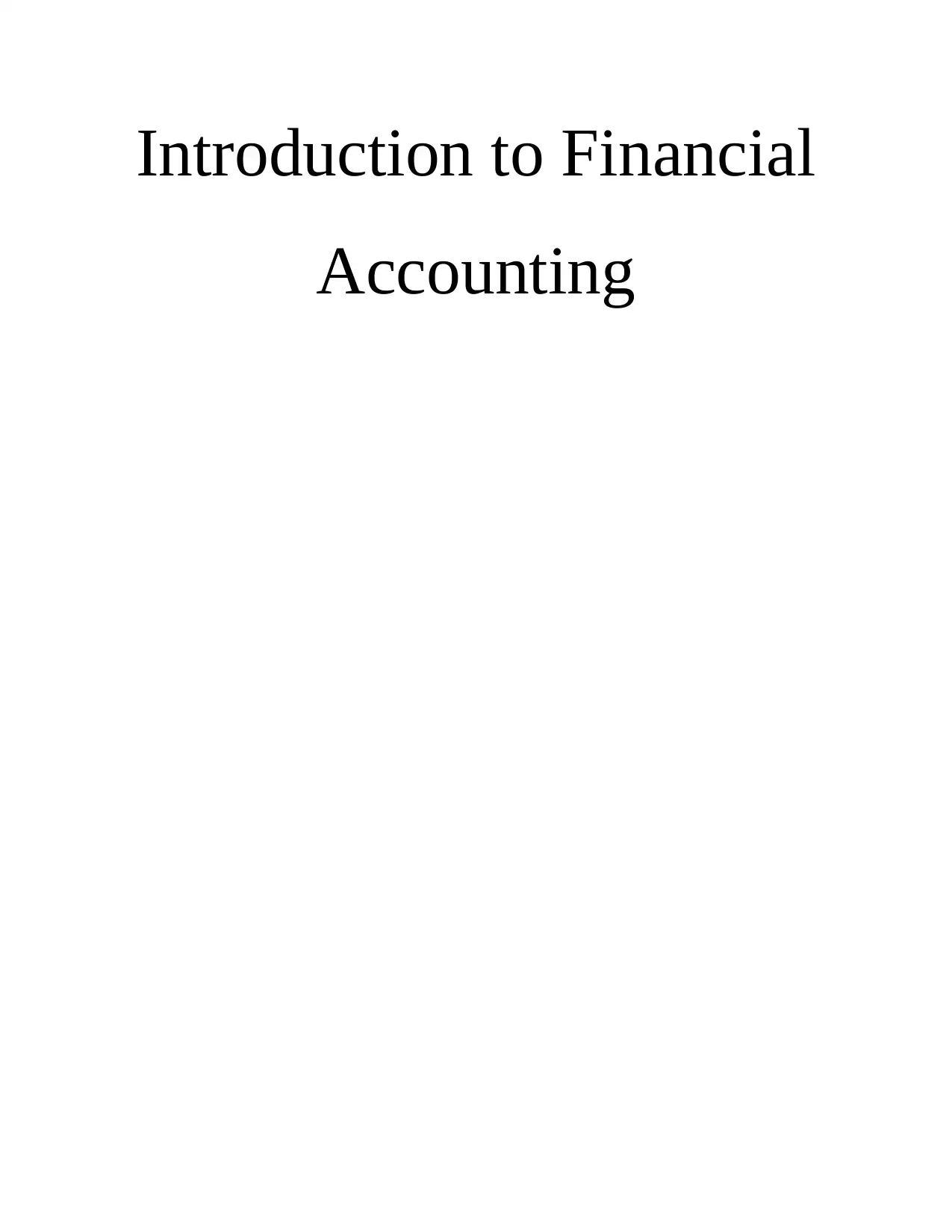
Introduction to Financial
Accounting
Accounting
Paraphrase This Document
Need a fresh take? Get an instant paraphrase of this document with our AI Paraphraser
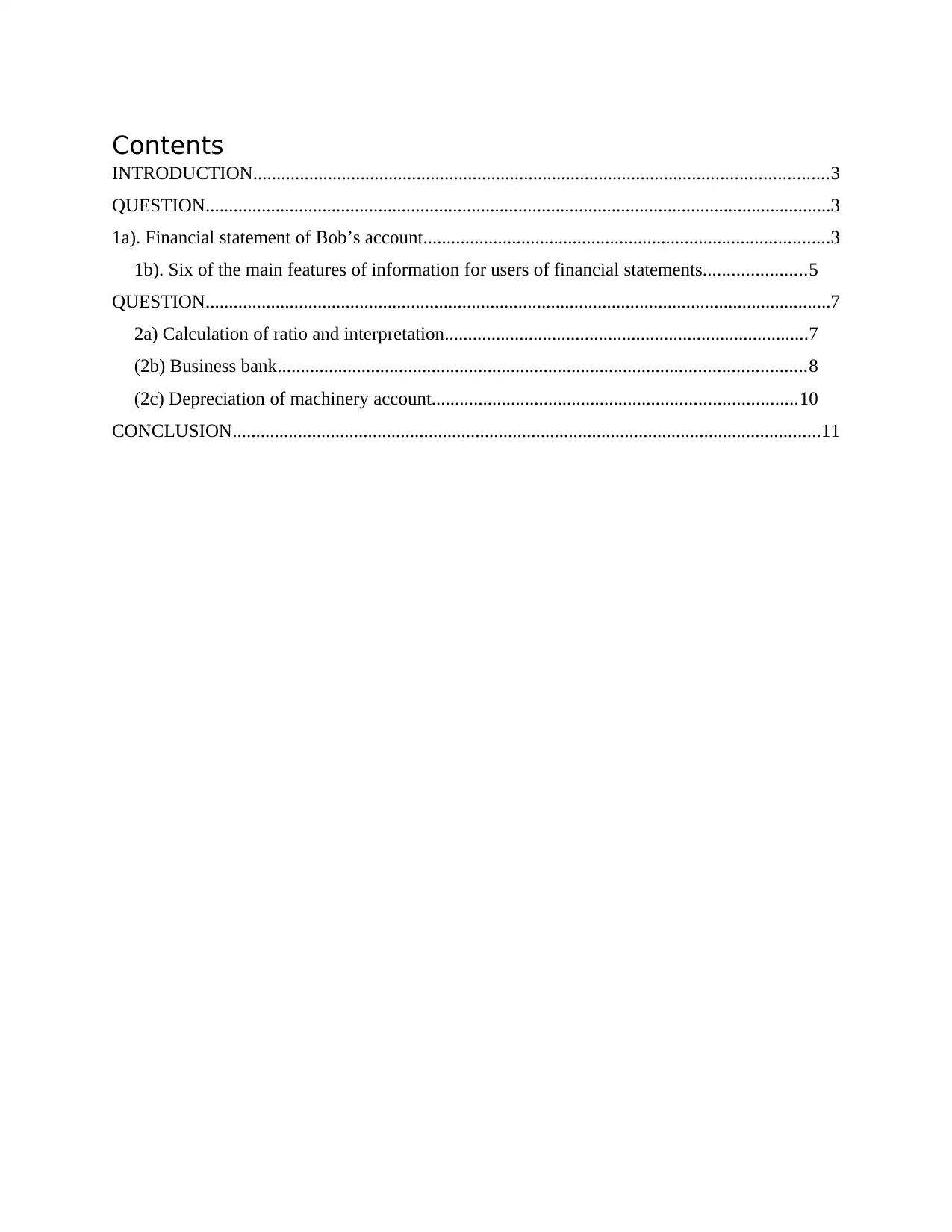
Contents
INTRODUCTION...........................................................................................................................3
QUESTION......................................................................................................................................3
1a). Financial statement of Bob’s account.......................................................................................3
1b). Six of the main features of information for users of financial statements......................5
QUESTION......................................................................................................................................7
2a) Calculation of ratio and interpretation..............................................................................7
(2b) Business bank.................................................................................................................8
(2c) Depreciation of machinery account..............................................................................10
CONCLUSION..............................................................................................................................11
INTRODUCTION...........................................................................................................................3
QUESTION......................................................................................................................................3
1a). Financial statement of Bob’s account.......................................................................................3
1b). Six of the main features of information for users of financial statements......................5
QUESTION......................................................................................................................................7
2a) Calculation of ratio and interpretation..............................................................................7
(2b) Business bank.................................................................................................................8
(2c) Depreciation of machinery account..............................................................................10
CONCLUSION..............................................................................................................................11
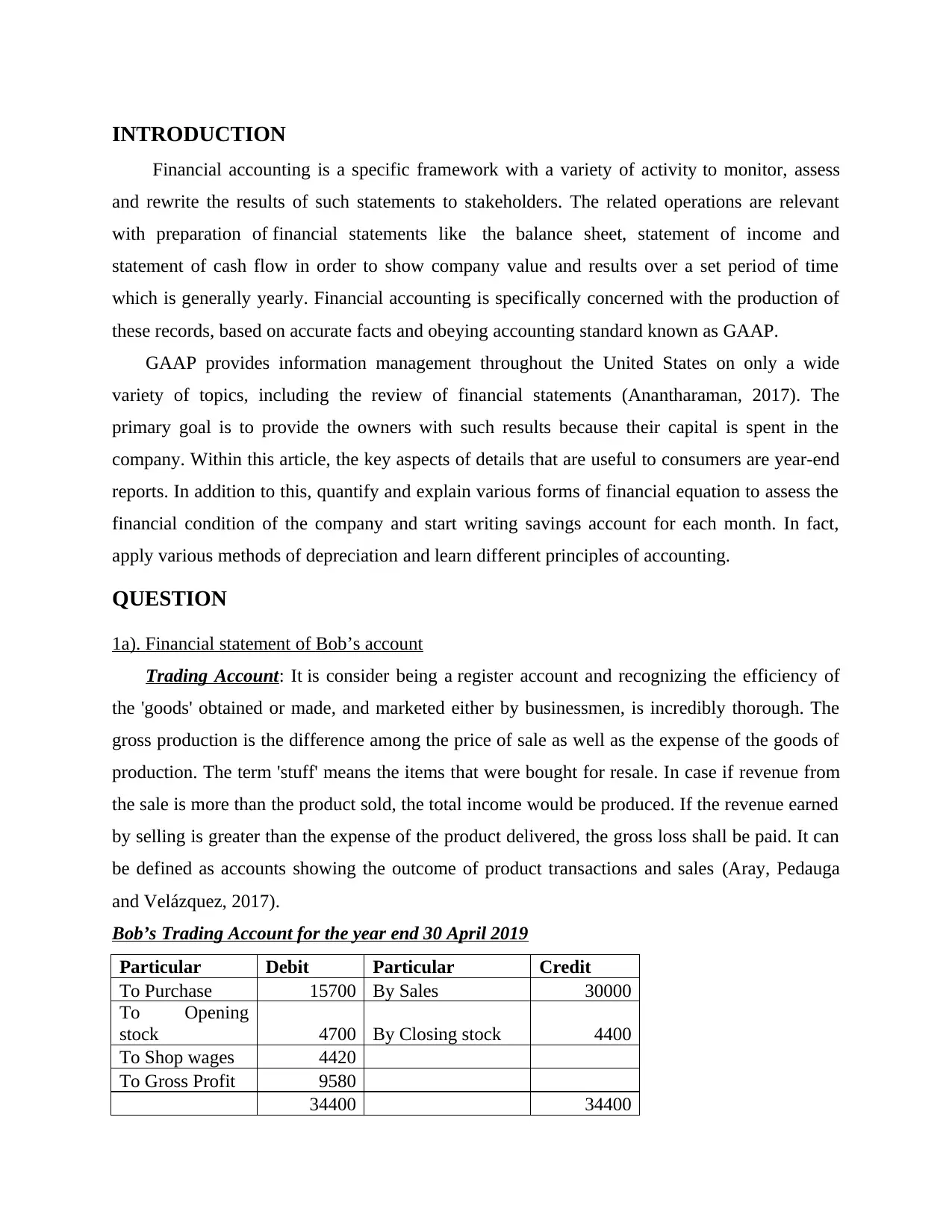
INTRODUCTION
Financial accounting is a specific framework with a variety of activity to monitor, assess
and rewrite the results of such statements to stakeholders. The related operations are relevant
with preparation of financial statements like the balance sheet, statement of income and
statement of cash flow in order to show company value and results over a set period of time
which is generally yearly. Financial accounting is specifically concerned with the production of
these records, based on accurate facts and obeying accounting standard known as GAAP.
GAAP provides information management throughout the United States on only a wide
variety of topics, including the review of financial statements (Anantharaman, 2017). The
primary goal is to provide the owners with such results because their capital is spent in the
company. Within this article, the key aspects of details that are useful to consumers are year-end
reports. In addition to this, quantify and explain various forms of financial equation to assess the
financial condition of the company and start writing savings account for each month. In fact,
apply various methods of depreciation and learn different principles of accounting.
QUESTION
1a). Financial statement of Bob’s account
Trading Account: It is consider being a register account and recognizing the efficiency of
the 'goods' obtained or made, and marketed either by businessmen, is incredibly thorough. The
gross production is the difference among the price of sale as well as the expense of the goods of
production. The term 'stuff' means the items that were bought for resale. In case if revenue from
the sale is more than the product sold, the total income would be produced. If the revenue earned
by selling is greater than the expense of the product delivered, the gross loss shall be paid. It can
be defined as accounts showing the outcome of product transactions and sales (Aray, Pedauga
and Velázquez, 2017).
Bob’s Trading Account for the year end 30 April 2019
Particular Debit Particular Credit
To Purchase 15700 By Sales 30000
To Opening
stock 4700 By Closing stock 4400
To Shop wages 4420
To Gross Profit 9580
34400 34400
Financial accounting is a specific framework with a variety of activity to monitor, assess
and rewrite the results of such statements to stakeholders. The related operations are relevant
with preparation of financial statements like the balance sheet, statement of income and
statement of cash flow in order to show company value and results over a set period of time
which is generally yearly. Financial accounting is specifically concerned with the production of
these records, based on accurate facts and obeying accounting standard known as GAAP.
GAAP provides information management throughout the United States on only a wide
variety of topics, including the review of financial statements (Anantharaman, 2017). The
primary goal is to provide the owners with such results because their capital is spent in the
company. Within this article, the key aspects of details that are useful to consumers are year-end
reports. In addition to this, quantify and explain various forms of financial equation to assess the
financial condition of the company and start writing savings account for each month. In fact,
apply various methods of depreciation and learn different principles of accounting.
QUESTION
1a). Financial statement of Bob’s account
Trading Account: It is consider being a register account and recognizing the efficiency of
the 'goods' obtained or made, and marketed either by businessmen, is incredibly thorough. The
gross production is the difference among the price of sale as well as the expense of the goods of
production. The term 'stuff' means the items that were bought for resale. In case if revenue from
the sale is more than the product sold, the total income would be produced. If the revenue earned
by selling is greater than the expense of the product delivered, the gross loss shall be paid. It can
be defined as accounts showing the outcome of product transactions and sales (Aray, Pedauga
and Velázquez, 2017).
Bob’s Trading Account for the year end 30 April 2019
Particular Debit Particular Credit
To Purchase 15700 By Sales 30000
To Opening
stock 4700 By Closing stock 4400
To Shop wages 4420
To Gross Profit 9580
34400 34400
⊘ This is a preview!⊘
Do you want full access?
Subscribe today to unlock all pages.

Trusted by 1+ million students worldwide
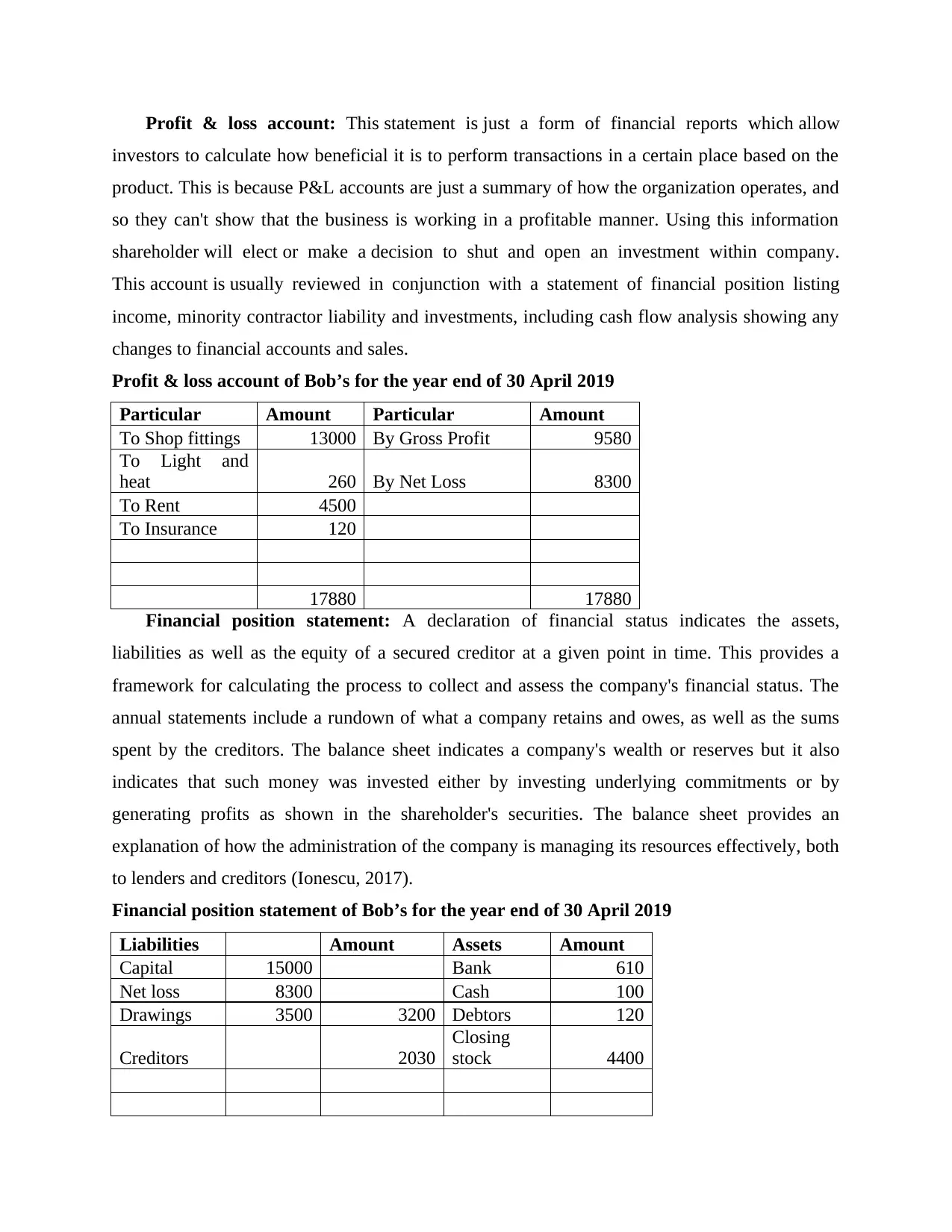
Profit & loss account: This statement is just a form of financial reports which allow
investors to calculate how beneficial it is to perform transactions in a certain place based on the
product. This is because P&L accounts are just a summary of how the organization operates, and
so they can't show that the business is working in a profitable manner. Using this information
shareholder will elect or make a decision to shut and open an investment within company.
This account is usually reviewed in conjunction with a statement of financial position listing
income, minority contractor liability and investments, including cash flow analysis showing any
changes to financial accounts and sales.
Profit & loss account of Bob’s for the year end of 30 April 2019
Particular Amount Particular Amount
To Shop fittings 13000 By Gross Profit 9580
To Light and
heat 260 By Net Loss 8300
To Rent 4500
To Insurance 120
17880 17880
Financial position statement: A declaration of financial status indicates the assets,
liabilities as well as the equity of a secured creditor at a given point in time. This provides a
framework for calculating the process to collect and assess the company's financial status. The
annual statements include a rundown of what a company retains and owes, as well as the sums
spent by the creditors. The balance sheet indicates a company's wealth or reserves but it also
indicates that such money was invested either by investing underlying commitments or by
generating profits as shown in the shareholder's securities. The balance sheet provides an
explanation of how the administration of the company is managing its resources effectively, both
to lenders and creditors (Ionescu, 2017).
Financial position statement of Bob’s for the year end of 30 April 2019
Liabilities Amount Assets Amount
Capital 15000 Bank 610
Net loss 8300 Cash 100
Drawings 3500 3200 Debtors 120
Creditors 2030
Closing
stock 4400
investors to calculate how beneficial it is to perform transactions in a certain place based on the
product. This is because P&L accounts are just a summary of how the organization operates, and
so they can't show that the business is working in a profitable manner. Using this information
shareholder will elect or make a decision to shut and open an investment within company.
This account is usually reviewed in conjunction with a statement of financial position listing
income, minority contractor liability and investments, including cash flow analysis showing any
changes to financial accounts and sales.
Profit & loss account of Bob’s for the year end of 30 April 2019
Particular Amount Particular Amount
To Shop fittings 13000 By Gross Profit 9580
To Light and
heat 260 By Net Loss 8300
To Rent 4500
To Insurance 120
17880 17880
Financial position statement: A declaration of financial status indicates the assets,
liabilities as well as the equity of a secured creditor at a given point in time. This provides a
framework for calculating the process to collect and assess the company's financial status. The
annual statements include a rundown of what a company retains and owes, as well as the sums
spent by the creditors. The balance sheet indicates a company's wealth or reserves but it also
indicates that such money was invested either by investing underlying commitments or by
generating profits as shown in the shareholder's securities. The balance sheet provides an
explanation of how the administration of the company is managing its resources effectively, both
to lenders and creditors (Ionescu, 2017).
Financial position statement of Bob’s for the year end of 30 April 2019
Liabilities Amount Assets Amount
Capital 15000 Bank 610
Net loss 8300 Cash 100
Drawings 3500 3200 Debtors 120
Creditors 2030
Closing
stock 4400
Paraphrase This Document
Need a fresh take? Get an instant paraphrase of this document with our AI Paraphraser
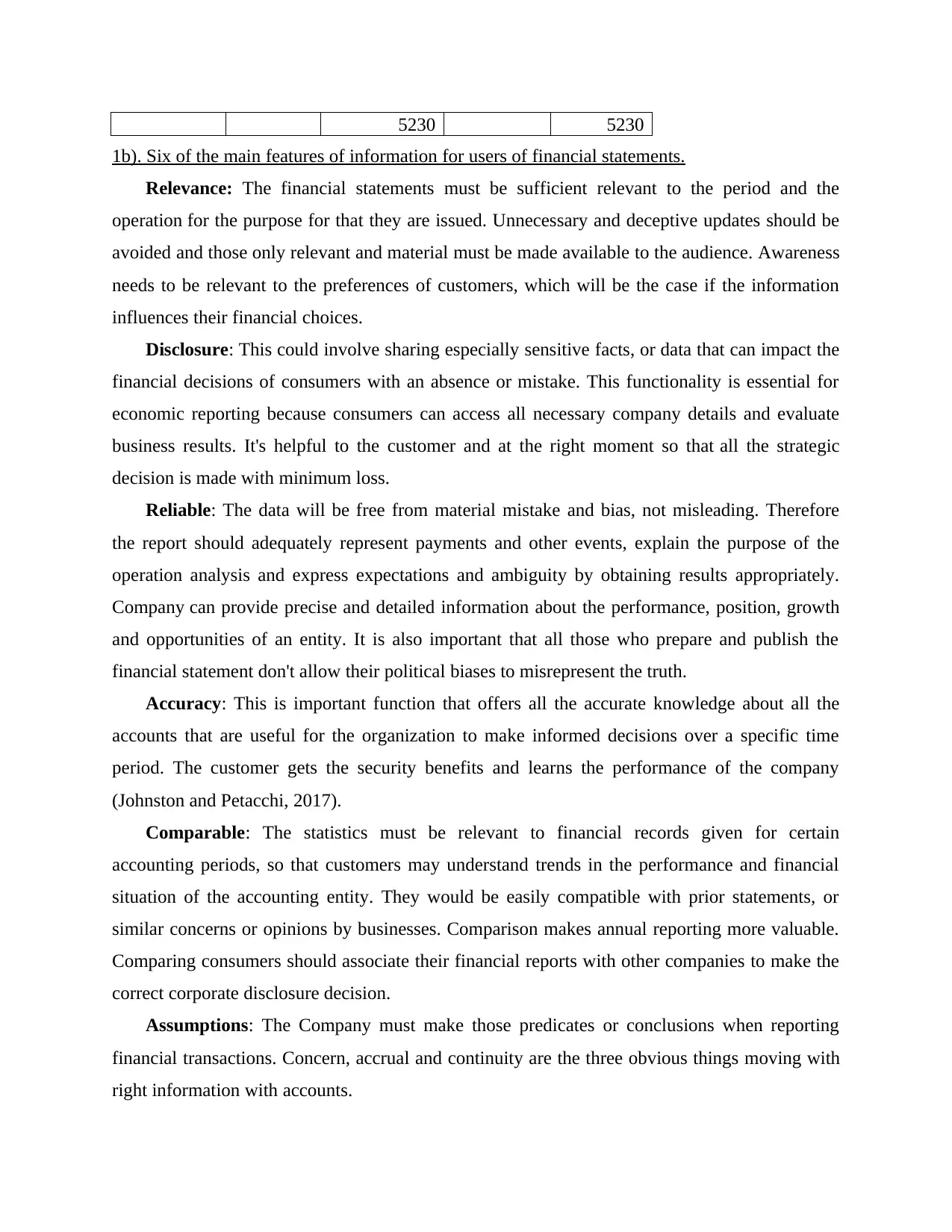
5230 5230
1b). Six of the main features of information for users of financial statements.
Relevance: The financial statements must be sufficient relevant to the period and the
operation for the purpose for that they are issued. Unnecessary and deceptive updates should be
avoided and those only relevant and material must be made available to the audience. Awareness
needs to be relevant to the preferences of customers, which will be the case if the information
influences their financial choices.
Disclosure: This could involve sharing especially sensitive facts, or data that can impact the
financial decisions of consumers with an absence or mistake. This functionality is essential for
economic reporting because consumers can access all necessary company details and evaluate
business results. It's helpful to the customer and at the right moment so that all the strategic
decision is made with minimum loss.
Reliable: The data will be free from material mistake and bias, not misleading. Therefore
the report should adequately represent payments and other events, explain the purpose of the
operation analysis and express expectations and ambiguity by obtaining results appropriately.
Company can provide precise and detailed information about the performance, position, growth
and opportunities of an entity. It is also important that all those who prepare and publish the
financial statement don't allow their political biases to misrepresent the truth.
Accuracy: This is important function that offers all the accurate knowledge about all the
accounts that are useful for the organization to make informed decisions over a specific time
period. The customer gets the security benefits and learns the performance of the company
(Johnston and Petacchi, 2017).
Comparable: The statistics must be relevant to financial records given for certain
accounting periods, so that customers may understand trends in the performance and financial
situation of the accounting entity. They would be easily compatible with prior statements, or
similar concerns or opinions by businesses. Comparison makes annual reporting more valuable.
Comparing consumers should associate their financial reports with other companies to make the
correct corporate disclosure decision.
Assumptions: The Company must make those predicates or conclusions when reporting
financial transactions. Concern, accrual and continuity are the three obvious things moving with
right information with accounts.
1b). Six of the main features of information for users of financial statements.
Relevance: The financial statements must be sufficient relevant to the period and the
operation for the purpose for that they are issued. Unnecessary and deceptive updates should be
avoided and those only relevant and material must be made available to the audience. Awareness
needs to be relevant to the preferences of customers, which will be the case if the information
influences their financial choices.
Disclosure: This could involve sharing especially sensitive facts, or data that can impact the
financial decisions of consumers with an absence or mistake. This functionality is essential for
economic reporting because consumers can access all necessary company details and evaluate
business results. It's helpful to the customer and at the right moment so that all the strategic
decision is made with minimum loss.
Reliable: The data will be free from material mistake and bias, not misleading. Therefore
the report should adequately represent payments and other events, explain the purpose of the
operation analysis and express expectations and ambiguity by obtaining results appropriately.
Company can provide precise and detailed information about the performance, position, growth
and opportunities of an entity. It is also important that all those who prepare and publish the
financial statement don't allow their political biases to misrepresent the truth.
Accuracy: This is important function that offers all the accurate knowledge about all the
accounts that are useful for the organization to make informed decisions over a specific time
period. The customer gets the security benefits and learns the performance of the company
(Johnston and Petacchi, 2017).
Comparable: The statistics must be relevant to financial records given for certain
accounting periods, so that customers may understand trends in the performance and financial
situation of the accounting entity. They would be easily compatible with prior statements, or
similar concerns or opinions by businesses. Comparison makes annual reporting more valuable.
Comparing consumers should associate their financial reports with other companies to make the
correct corporate disclosure decision.
Assumptions: The Company must make those predicates or conclusions when reporting
financial transactions. Concern, accrual and continuity are the three obvious things moving with
right information with accounts.
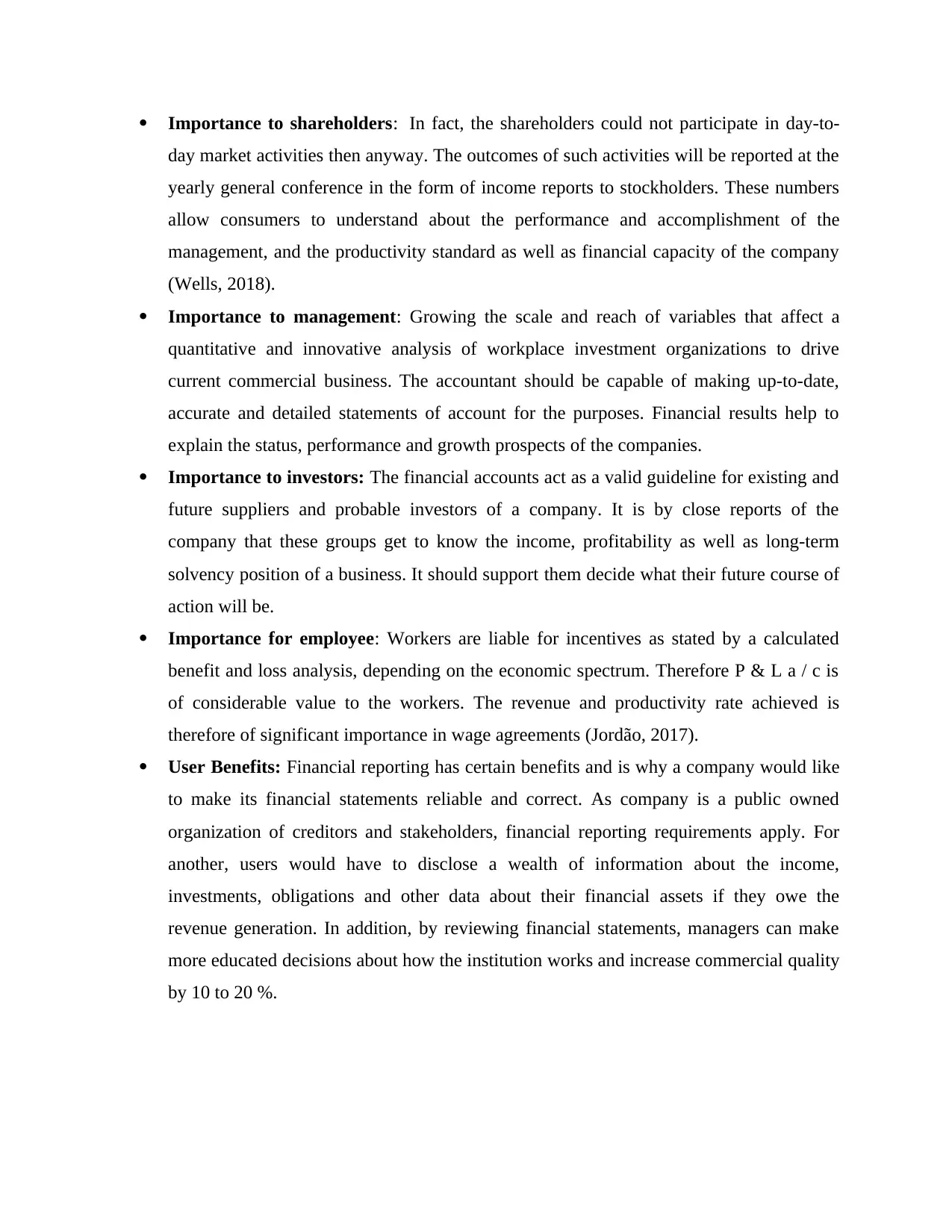
Importance to shareholders: In fact, the shareholders could not participate in day-to-
day market activities then anyway. The outcomes of such activities will be reported at the
yearly general conference in the form of income reports to stockholders. These numbers
allow consumers to understand about the performance and accomplishment of the
management, and the productivity standard as well as financial capacity of the company
(Wells, 2018).
Importance to management: Growing the scale and reach of variables that affect a
quantitative and innovative analysis of workplace investment organizations to drive
current commercial business. The accountant should be capable of making up-to-date,
accurate and detailed statements of account for the purposes. Financial results help to
explain the status, performance and growth prospects of the companies.
Importance to investors: The financial accounts act as a valid guideline for existing and
future suppliers and probable investors of a company. It is by close reports of the
company that these groups get to know the income, profitability as well as long-term
solvency position of a business. It should support them decide what their future course of
action will be.
Importance for employee: Workers are liable for incentives as stated by a calculated
benefit and loss analysis, depending on the economic spectrum. Therefore P & L a / c is
of considerable value to the workers. The revenue and productivity rate achieved is
therefore of significant importance in wage agreements (Jordão, 2017).
User Benefits: Financial reporting has certain benefits and is why a company would like
to make its financial statements reliable and correct. As company is a public owned
organization of creditors and stakeholders, financial reporting requirements apply. For
another, users would have to disclose a wealth of information about the income,
investments, obligations and other data about their financial assets if they owe the
revenue generation. In addition, by reviewing financial statements, managers can make
more educated decisions about how the institution works and increase commercial quality
by 10 to 20 %.
day market activities then anyway. The outcomes of such activities will be reported at the
yearly general conference in the form of income reports to stockholders. These numbers
allow consumers to understand about the performance and accomplishment of the
management, and the productivity standard as well as financial capacity of the company
(Wells, 2018).
Importance to management: Growing the scale and reach of variables that affect a
quantitative and innovative analysis of workplace investment organizations to drive
current commercial business. The accountant should be capable of making up-to-date,
accurate and detailed statements of account for the purposes. Financial results help to
explain the status, performance and growth prospects of the companies.
Importance to investors: The financial accounts act as a valid guideline for existing and
future suppliers and probable investors of a company. It is by close reports of the
company that these groups get to know the income, profitability as well as long-term
solvency position of a business. It should support them decide what their future course of
action will be.
Importance for employee: Workers are liable for incentives as stated by a calculated
benefit and loss analysis, depending on the economic spectrum. Therefore P & L a / c is
of considerable value to the workers. The revenue and productivity rate achieved is
therefore of significant importance in wage agreements (Jordão, 2017).
User Benefits: Financial reporting has certain benefits and is why a company would like
to make its financial statements reliable and correct. As company is a public owned
organization of creditors and stakeholders, financial reporting requirements apply. For
another, users would have to disclose a wealth of information about the income,
investments, obligations and other data about their financial assets if they owe the
revenue generation. In addition, by reviewing financial statements, managers can make
more educated decisions about how the institution works and increase commercial quality
by 10 to 20 %.
⊘ This is a preview!⊘
Do you want full access?
Subscribe today to unlock all pages.

Trusted by 1+ million students worldwide
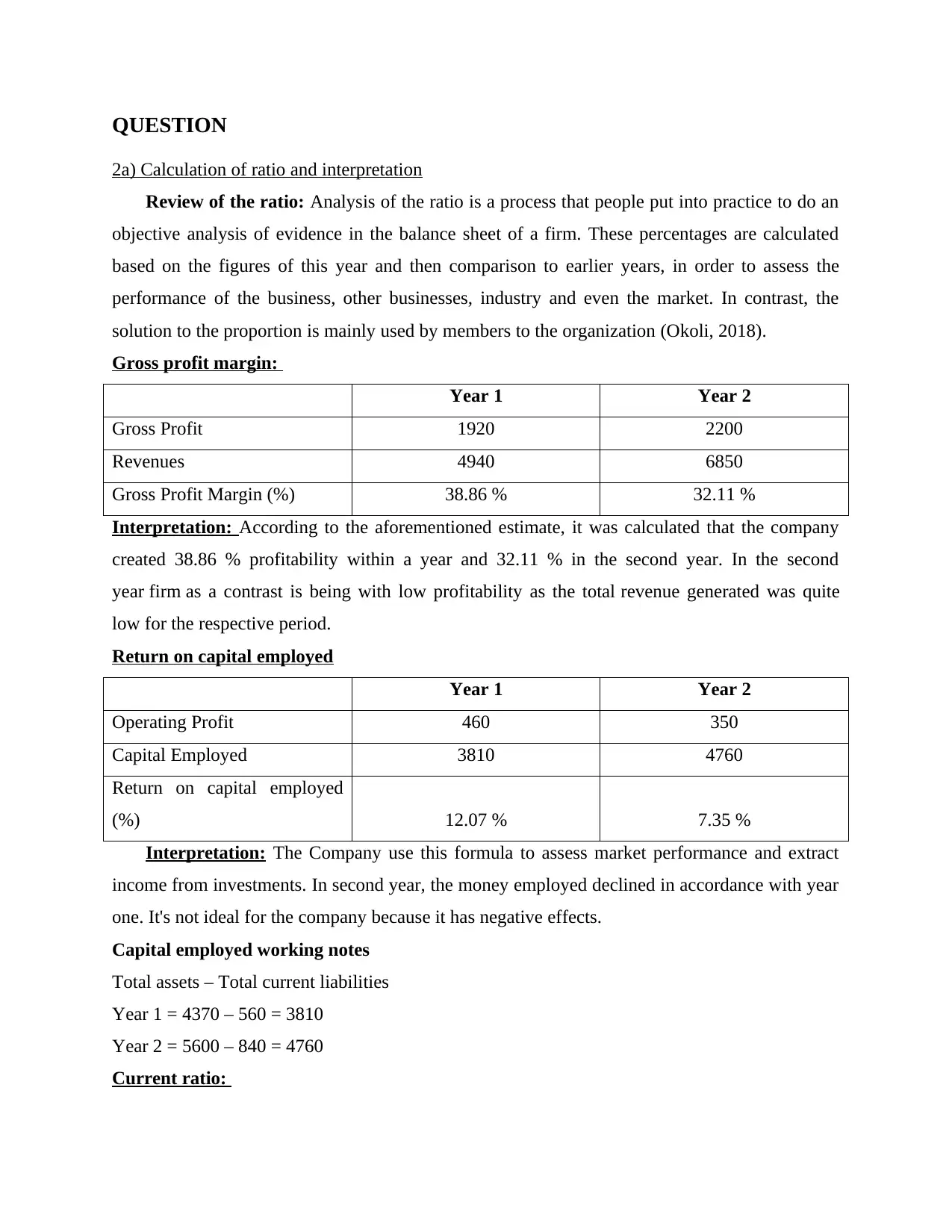
QUESTION
2a) Calculation of ratio and interpretation
Review of the ratio: Analysis of the ratio is a process that people put into practice to do an
objective analysis of evidence in the balance sheet of a firm. These percentages are calculated
based on the figures of this year and then comparison to earlier years, in order to assess the
performance of the business, other businesses, industry and even the market. In contrast, the
solution to the proportion is mainly used by members to the organization (Okoli, 2018).
Gross profit margin:
Year 1 Year 2
Gross Profit 1920 2200
Revenues 4940 6850
Gross Profit Margin (%) 38.86 % 32.11 %
Interpretation: According to the aforementioned estimate, it was calculated that the company
created 38.86 % profitability within a year and 32.11 % in the second year. In the second
year firm as a contrast is being with low profitability as the total revenue generated was quite
low for the respective period.
Return on capital employed
Year 1 Year 2
Operating Profit 460 350
Capital Employed 3810 4760
Return on capital employed
(%) 12.07 % 7.35 %
Interpretation: The Company use this formula to assess market performance and extract
income from investments. In second year, the money employed declined in accordance with year
one. It's not ideal for the company because it has negative effects.
Capital employed working notes
Total assets – Total current liabilities
Year 1 = 4370 – 560 = 3810
Year 2 = 5600 – 840 = 4760
Current ratio:
2a) Calculation of ratio and interpretation
Review of the ratio: Analysis of the ratio is a process that people put into practice to do an
objective analysis of evidence in the balance sheet of a firm. These percentages are calculated
based on the figures of this year and then comparison to earlier years, in order to assess the
performance of the business, other businesses, industry and even the market. In contrast, the
solution to the proportion is mainly used by members to the organization (Okoli, 2018).
Gross profit margin:
Year 1 Year 2
Gross Profit 1920 2200
Revenues 4940 6850
Gross Profit Margin (%) 38.86 % 32.11 %
Interpretation: According to the aforementioned estimate, it was calculated that the company
created 38.86 % profitability within a year and 32.11 % in the second year. In the second
year firm as a contrast is being with low profitability as the total revenue generated was quite
low for the respective period.
Return on capital employed
Year 1 Year 2
Operating Profit 460 350
Capital Employed 3810 4760
Return on capital employed
(%) 12.07 % 7.35 %
Interpretation: The Company use this formula to assess market performance and extract
income from investments. In second year, the money employed declined in accordance with year
one. It's not ideal for the company because it has negative effects.
Capital employed working notes
Total assets – Total current liabilities
Year 1 = 4370 – 560 = 3810
Year 2 = 5600 – 840 = 4760
Current ratio:
Paraphrase This Document
Need a fresh take? Get an instant paraphrase of this document with our AI Paraphraser
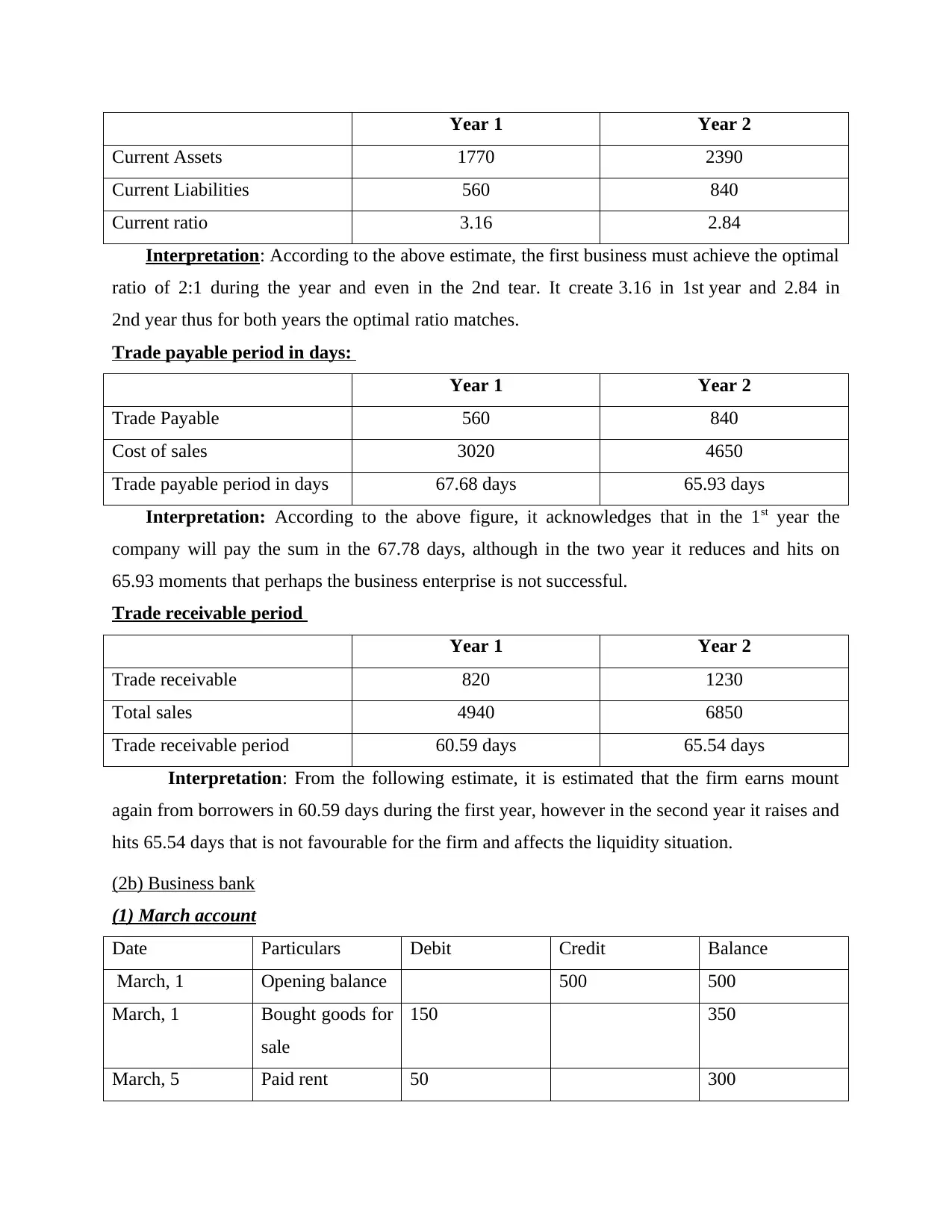
Year 1 Year 2
Current Assets 1770 2390
Current Liabilities 560 840
Current ratio 3.16 2.84
Interpretation: According to the above estimate, the first business must achieve the optimal
ratio of 2:1 during the year and even in the 2nd tear. It create 3.16 in 1st year and 2.84 in
2nd year thus for both years the optimal ratio matches.
Trade payable period in days:
Year 1 Year 2
Trade Payable 560 840
Cost of sales 3020 4650
Trade payable period in days 67.68 days 65.93 days
Interpretation: According to the above figure, it acknowledges that in the 1st year the
company will pay the sum in the 67.78 days, although in the two year it reduces and hits on
65.93 moments that perhaps the business enterprise is not successful.
Trade receivable period
Year 1 Year 2
Trade receivable 820 1230
Total sales 4940 6850
Trade receivable period 60.59 days 65.54 days
Interpretation: From the following estimate, it is estimated that the firm earns mount
again from borrowers in 60.59 days during the first year, however in the second year it raises and
hits 65.54 days that is not favourable for the firm and affects the liquidity situation.
(2b) Business bank
(1) March account
Date Particulars Debit Credit Balance
March, 1 Opening balance 500 500
March, 1 Bought goods for
sale
150 350
March, 5 Paid rent 50 300
Current Assets 1770 2390
Current Liabilities 560 840
Current ratio 3.16 2.84
Interpretation: According to the above estimate, the first business must achieve the optimal
ratio of 2:1 during the year and even in the 2nd tear. It create 3.16 in 1st year and 2.84 in
2nd year thus for both years the optimal ratio matches.
Trade payable period in days:
Year 1 Year 2
Trade Payable 560 840
Cost of sales 3020 4650
Trade payable period in days 67.68 days 65.93 days
Interpretation: According to the above figure, it acknowledges that in the 1st year the
company will pay the sum in the 67.78 days, although in the two year it reduces and hits on
65.93 moments that perhaps the business enterprise is not successful.
Trade receivable period
Year 1 Year 2
Trade receivable 820 1230
Total sales 4940 6850
Trade receivable period 60.59 days 65.54 days
Interpretation: From the following estimate, it is estimated that the firm earns mount
again from borrowers in 60.59 days during the first year, however in the second year it raises and
hits 65.54 days that is not favourable for the firm and affects the liquidity situation.
(2b) Business bank
(1) March account
Date Particulars Debit Credit Balance
March, 1 Opening balance 500 500
March, 1 Bought goods for
sale
150 350
March, 5 Paid rent 50 300
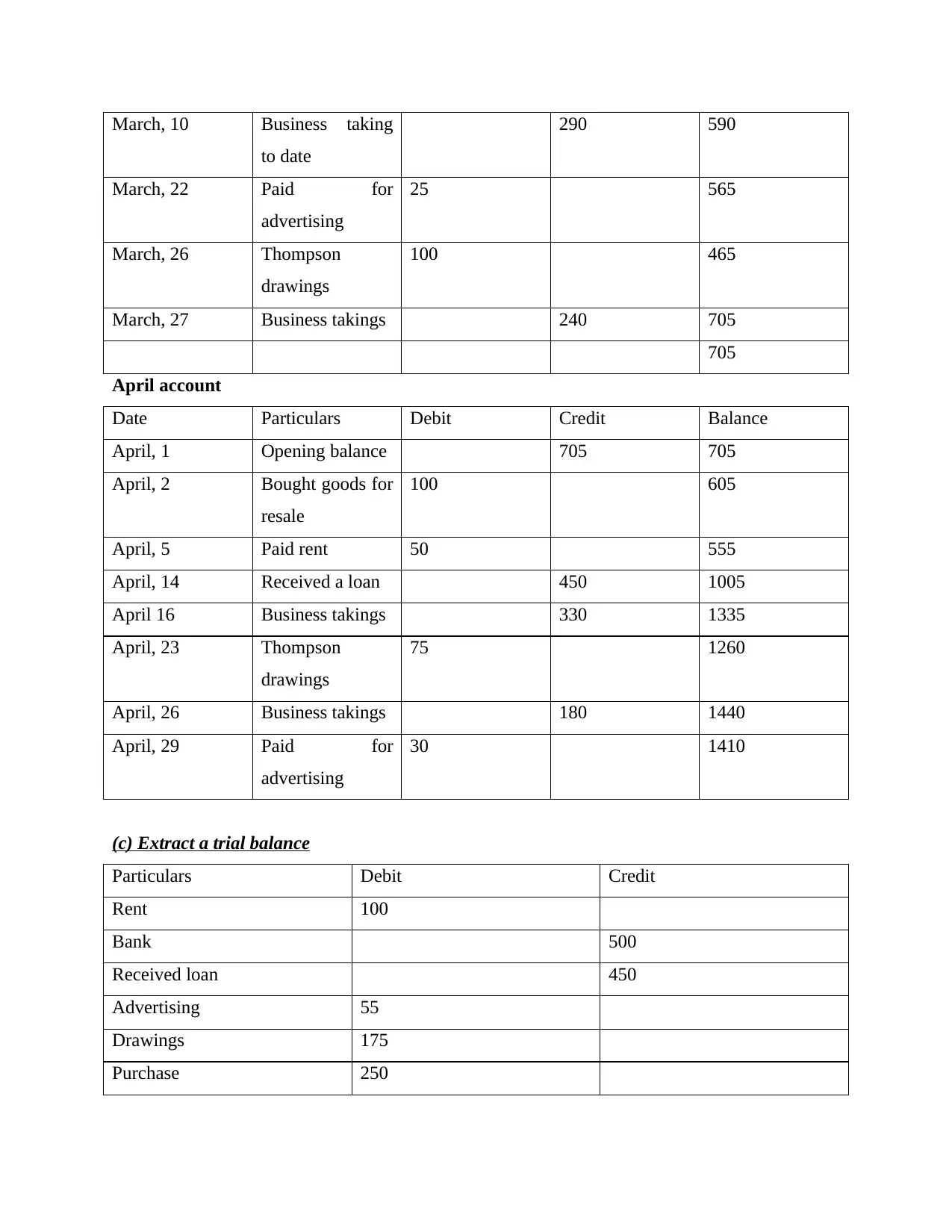
March, 10 Business taking
to date
290 590
March, 22 Paid for
advertising
25 565
March, 26 Thompson
drawings
100 465
March, 27 Business takings 240 705
705
April account
Date Particulars Debit Credit Balance
April, 1 Opening balance 705 705
April, 2 Bought goods for
resale
100 605
April, 5 Paid rent 50 555
April, 14 Received a loan 450 1005
April 16 Business takings 330 1335
April, 23 Thompson
drawings
75 1260
April, 26 Business takings 180 1440
April, 29 Paid for
advertising
30 1410
(c) Extract a trial balance
Particulars Debit Credit
Rent 100
Bank 500
Received loan 450
Advertising 55
Drawings 175
Purchase 250
to date
290 590
March, 22 Paid for
advertising
25 565
March, 26 Thompson
drawings
100 465
March, 27 Business takings 240 705
705
April account
Date Particulars Debit Credit Balance
April, 1 Opening balance 705 705
April, 2 Bought goods for
resale
100 605
April, 5 Paid rent 50 555
April, 14 Received a loan 450 1005
April 16 Business takings 330 1335
April, 23 Thompson
drawings
75 1260
April, 26 Business takings 180 1440
April, 29 Paid for
advertising
30 1410
(c) Extract a trial balance
Particulars Debit Credit
Rent 100
Bank 500
Received loan 450
Advertising 55
Drawings 175
Purchase 250
⊘ This is a preview!⊘
Do you want full access?
Subscribe today to unlock all pages.

Trusted by 1+ million students worldwide

suspense 370
950 950
(2c) Depreciation of machinery account
Straight line method (12.5%)
For 2017 = Cost of machinery*12.5%
= 16000 * 12.5%
= 2000
For 2018 = 16000 * 12.5%
= 2000
For 2019 = 16000 * 12.5%
= 2000
(2) Reduce balance method (15%)
For 2017 = Cost of machinery*15%
= 16000 * 15%
= 2400
For 2018 = (16000-2400) * 15%
= 13600*15%
= 2040
For 2019 = (13600-2040) * 15%
= 11560 * 15%
= 1734
(3) Accounting concepts
Going concern: This is a business accounting term which will have the capital required
to continue working regularly before proof of the reverse is provided. The term also refers to a
company's ability to collect enough income to remain alive or through necessity flee. When a
corporation is not a corporation, it means it has gone bankrupt through forced liquidation of its
capital. Accounting experts use the principles of going concern to determine what accounting
methods should appear on the financial statements. Companies which are a continuing problem
950 950
(2c) Depreciation of machinery account
Straight line method (12.5%)
For 2017 = Cost of machinery*12.5%
= 16000 * 12.5%
= 2000
For 2018 = 16000 * 12.5%
= 2000
For 2019 = 16000 * 12.5%
= 2000
(2) Reduce balance method (15%)
For 2017 = Cost of machinery*15%
= 16000 * 15%
= 2400
For 2018 = (16000-2400) * 15%
= 13600*15%
= 2040
For 2019 = (13600-2040) * 15%
= 11560 * 15%
= 1734
(3) Accounting concepts
Going concern: This is a business accounting term which will have the capital required
to continue working regularly before proof of the reverse is provided. The term also refers to a
company's ability to collect enough income to remain alive or through necessity flee. When a
corporation is not a corporation, it means it has gone bankrupt through forced liquidation of its
capital. Accounting experts use the principles of going concern to determine what accounting
methods should appear on the financial statements. Companies which are a continuing problem
Paraphrase This Document
Need a fresh take? Get an instant paraphrase of this document with our AI Paraphraser
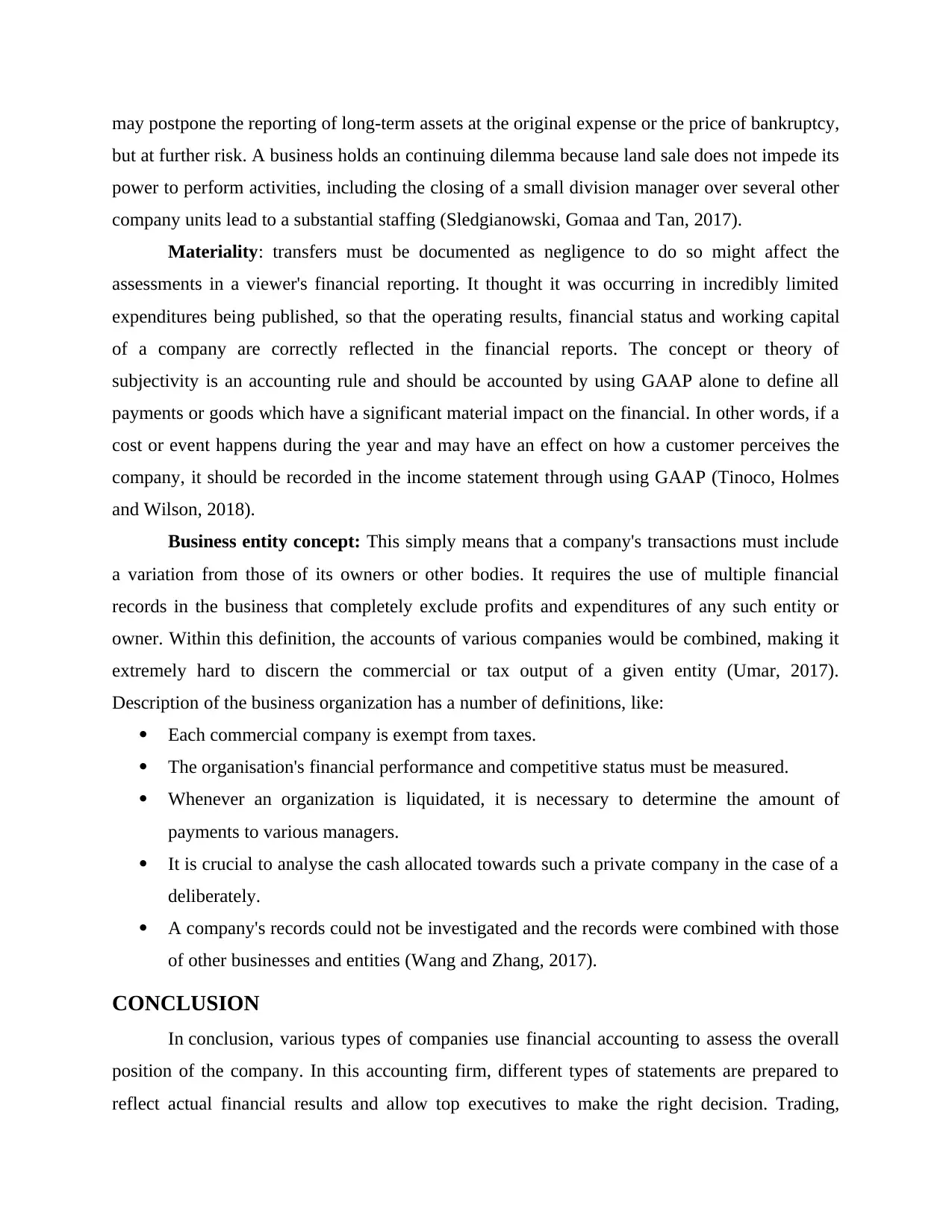
may postpone the reporting of long-term assets at the original expense or the price of bankruptcy,
but at further risk. A business holds an continuing dilemma because land sale does not impede its
power to perform activities, including the closing of a small division manager over several other
company units lead to a substantial staffing (Sledgianowski, Gomaa and Tan, 2017).
Materiality: transfers must be documented as negligence to do so might affect the
assessments in a viewer's financial reporting. It thought it was occurring in incredibly limited
expenditures being published, so that the operating results, financial status and working capital
of a company are correctly reflected in the financial reports. The concept or theory of
subjectivity is an accounting rule and should be accounted by using GAAP alone to define all
payments or goods which have a significant material impact on the financial. In other words, if a
cost or event happens during the year and may have an effect on how a customer perceives the
company, it should be recorded in the income statement through using GAAP (Tinoco, Holmes
and Wilson, 2018).
Business entity concept: This simply means that a company's transactions must include
a variation from those of its owners or other bodies. It requires the use of multiple financial
records in the business that completely exclude profits and expenditures of any such entity or
owner. Within this definition, the accounts of various companies would be combined, making it
extremely hard to discern the commercial or tax output of a given entity (Umar, 2017).
Description of the business organization has a number of definitions, like:
Each commercial company is exempt from taxes.
The organisation's financial performance and competitive status must be measured.
Whenever an organization is liquidated, it is necessary to determine the amount of
payments to various managers.
It is crucial to analyse the cash allocated towards such a private company in the case of a
deliberately.
A company's records could not be investigated and the records were combined with those
of other businesses and entities (Wang and Zhang, 2017).
CONCLUSION
In conclusion, various types of companies use financial accounting to assess the overall
position of the company. In this accounting firm, different types of statements are prepared to
reflect actual financial results and allow top executives to make the right decision. Trading,
but at further risk. A business holds an continuing dilemma because land sale does not impede its
power to perform activities, including the closing of a small division manager over several other
company units lead to a substantial staffing (Sledgianowski, Gomaa and Tan, 2017).
Materiality: transfers must be documented as negligence to do so might affect the
assessments in a viewer's financial reporting. It thought it was occurring in incredibly limited
expenditures being published, so that the operating results, financial status and working capital
of a company are correctly reflected in the financial reports. The concept or theory of
subjectivity is an accounting rule and should be accounted by using GAAP alone to define all
payments or goods which have a significant material impact on the financial. In other words, if a
cost or event happens during the year and may have an effect on how a customer perceives the
company, it should be recorded in the income statement through using GAAP (Tinoco, Holmes
and Wilson, 2018).
Business entity concept: This simply means that a company's transactions must include
a variation from those of its owners or other bodies. It requires the use of multiple financial
records in the business that completely exclude profits and expenditures of any such entity or
owner. Within this definition, the accounts of various companies would be combined, making it
extremely hard to discern the commercial or tax output of a given entity (Umar, 2017).
Description of the business organization has a number of definitions, like:
Each commercial company is exempt from taxes.
The organisation's financial performance and competitive status must be measured.
Whenever an organization is liquidated, it is necessary to determine the amount of
payments to various managers.
It is crucial to analyse the cash allocated towards such a private company in the case of a
deliberately.
A company's records could not be investigated and the records were combined with those
of other businesses and entities (Wang and Zhang, 2017).
CONCLUSION
In conclusion, various types of companies use financial accounting to assess the overall
position of the company. In this accounting firm, different types of statements are prepared to
reflect actual financial results and allow top executives to make the right decision. Trading,

income and expense accounts are made to assess the financial results. In this function often
measure with the advantages the research ratio and user experience functions.
measure with the advantages the research ratio and user experience functions.
⊘ This is a preview!⊘
Do you want full access?
Subscribe today to unlock all pages.

Trusted by 1+ million students worldwide
1 out of 13
Related Documents
Your All-in-One AI-Powered Toolkit for Academic Success.
+13062052269
info@desklib.com
Available 24*7 on WhatsApp / Email
![[object Object]](/_next/static/media/star-bottom.7253800d.svg)
Unlock your academic potential
Copyright © 2020–2025 A2Z Services. All Rights Reserved. Developed and managed by ZUCOL.





